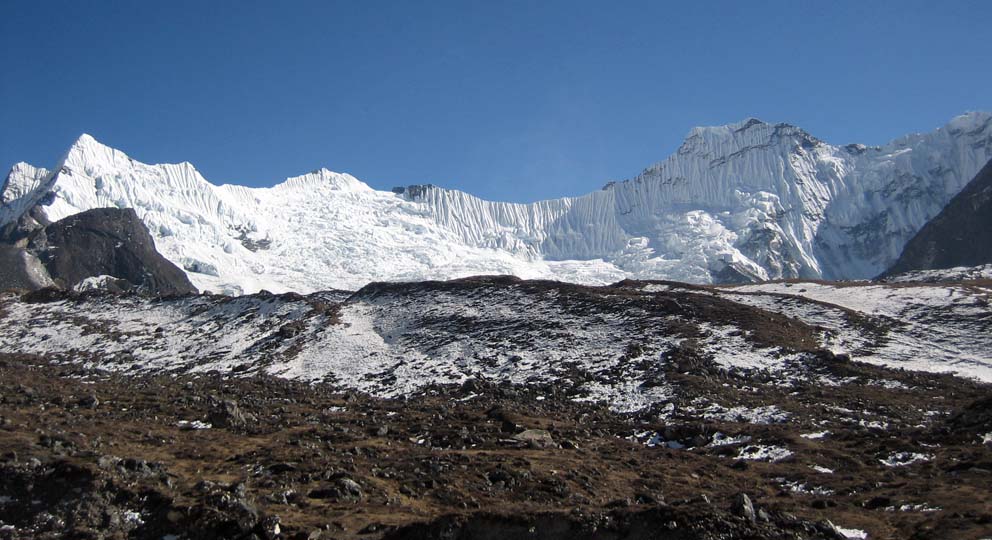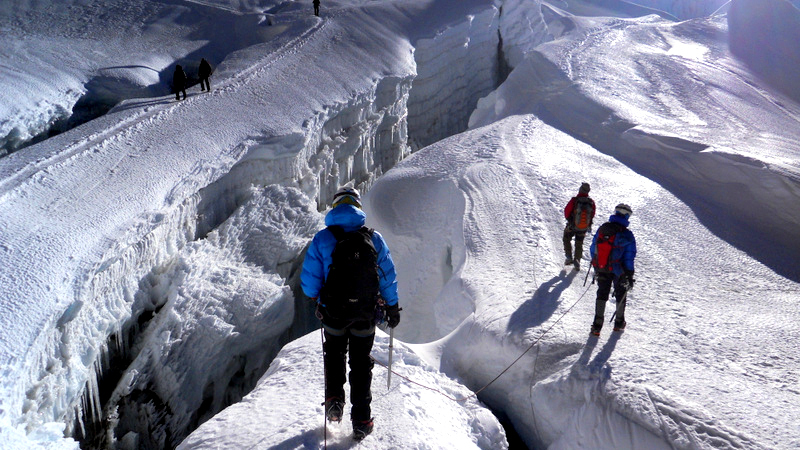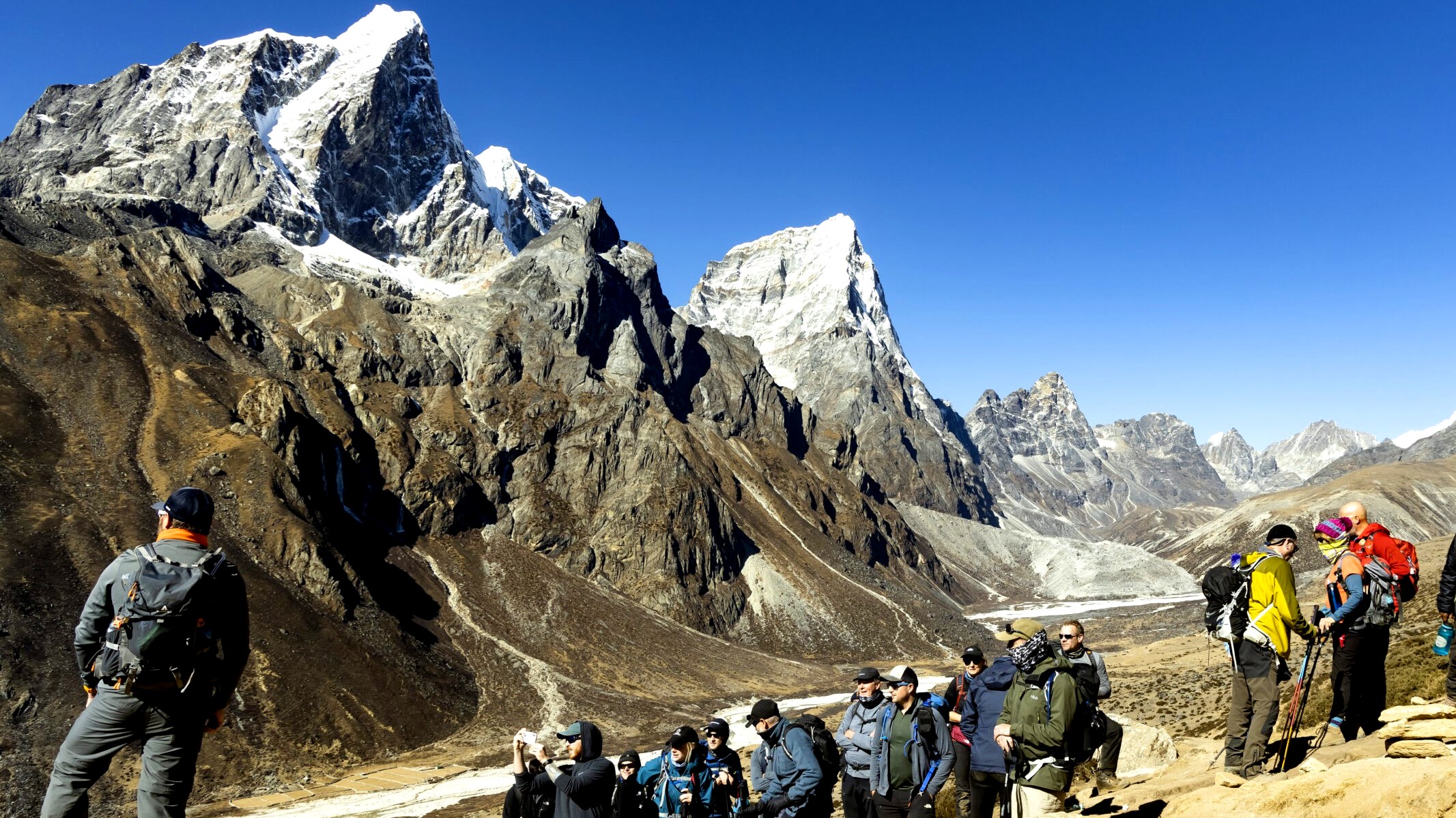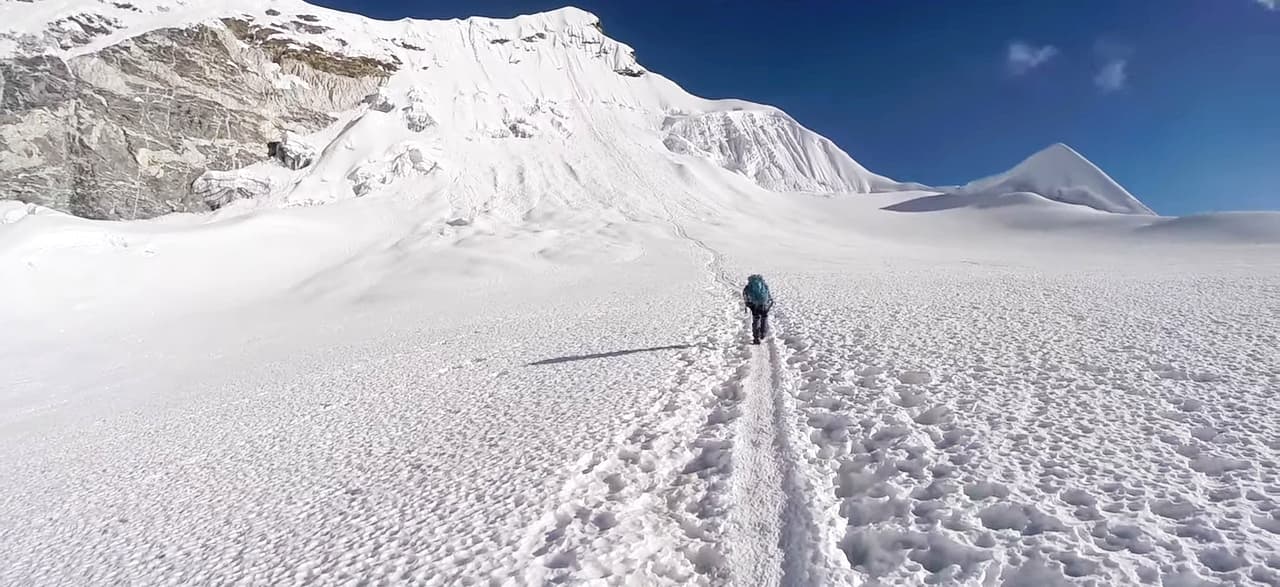Island Peak Climbing with Everest Base Camp Trek
The Island Peak Climbing with Everest Base Camp Trek is a thrilling adventure that combines two incredible experiences in the Everest region of Nepal. The journey begins with the classic Everest Base Camp Trek, taking you through picturesque Sherpa villages, lush forests, and the Dudh Koshi River. You'll reach Everest Base Camp, where climbers prepare for their summit attempts on the world's highest peak. Afterward, the focus shifts to Island Peak, a challenging climb that requires technical skills and mountaineering equipment. The summit offers breathtaking panoramic views of Everest and neighboring peaks.

This combined trek and climb typically lasts around 18-20 days. Prior trekking experience, physical fitness, and basic mountaineering skills are necessary for success. It's highly recommended to hire experienced guides or join a trekking company to ensure safety and receive proper support throughout the expedition. The journey provides an opportunity to immerse yourself in Sherpa culture, witness the awe-inspiring beauty of the Himalayas, and achieve the exhilarating feat of summiting a Himalayan peak.
Overall, the Island Peak Climbing with Everest Base Camp Trek is a remarkable adventure that combines the joys of trekking with the thrill of mountaineering. It allows you to experience the stunning landscapes and unique Sherpa culture of the Everest region while pushing your limits to reach the summit of Island Peak.
Highlights of the Island Peak Climbing with Everest Base Camp Trek
The Island Peak Climbing with Everest Base Camp Trek offers several highlights that make it a truly memorable and rewarding adventure. Here are some of the key highlights:
- Trek to Everest Base Camp, the starting point for Mount Everest summit attempts.
- Breathtaking views of iconic Himalayan peaks, including Mount Everest, Lhotse, Nuptse, and Ama Dablam.
- Immerse yourself in Sherpa culture and visit vibrant Sherpa villages like Namche Bazaar, Tengboche, and Dingboche.
- Witness the bustling atmosphere and camaraderie at Everest Base Camp during the climbing season.
- Summit Island Peak (Imja Tse) at an altitude of 6,189 meters (20,305 feet), requires technical climbing skills.
- Enjoy panoramic vistas from the Island Peak summit, offering stunning views of the Everest region.
- Trek through diverse landscapes, including lush forests, riverside trails, barren moraines, and icy glaciers.
- Experience proper acclimatization as you gradually ascend to higher altitudes.
- Create lifelong memories amidst the grandeur of the Himalayas, combining trekking and mountaineering.
These highlights encapsulate the thrilling and rewarding aspects of the Island Peak Climbing with Everest Base Camp Trek, offering a blend of natural beauty, cultural exploration, and mountaineering challenges.
Difficulty Level of the Island Peak Climbing with Everest Base Camp Trek
The Island Peak Climbing with Everest Base Camp Trek is considered a moderately challenging adventure. It requires a good level of physical fitness, prior trekking experience, and basic mountaineering skills. Here is an overview of the difficulty level:
Altitude
Altitude is a significant factor in the Island Peak Climbing with Everest Base Camp Trek. As you ascend to altitudes above 5,000 meters (16,400 feet), including Everest Base Camp and Island Peak, the decreased oxygen levels can pose challenges. Proper acclimatization is crucial to allow your body to adjust and minimize the risk of altitude sickness. It's important to listen to your body, follow a gradual ascent, and inform your guides of any symptoms. With adequate preparation, acclimatization, and awareness of altitude-related issues, you can safely enjoy the trek while taking in the breathtaking views of the Himalayas.

Trekking Duration and Terrain
The Island Peak Climbing with Everest Base Camp Trek has a moderate trekking duration of around 18-20 days. During this time, you'll cover a variety of terrains, ranging from well-marked paths to rocky and icy sections. The trail involves long days of walking, typically 5-8 hours per day, with some steep ascents and descents. Sturdy trekking boots are essential to navigate the diverse terrain. It's important to be physically prepared for the duration of the trek and be comfortable with walking for extended periods while traversing varying types of terrain.
Climbing Island Peak
Climbing Island Peak is a challenging and exhilarating part of the Island Peak Climbing with Everest Base Camp Trek. It requires basic mountaineering skills and equipment. The ascent involves traversing glaciers, ascending steep snow and ice slopes, and navigating crevasses. Training on mountaineering techniques, including the use of crampons, ice axes, ropes, and fixed line ascents, is provided at Island Peak Base Camp. The climb to the summit, located at an altitude of 6,189 meters (20,305 feet), offers stunning panoramic views of the surrounding Himalayan peaks, including Everest. It is a rewarding and memorable experience that requires physical stamina, mental determination, and a sense of adventure.
Weather Conditions
Weather conditions in the Everest region can be unpredictable and harsh, especially at higher altitudes. It's important to be prepared for changing weather patterns during the Island Peak Climbing with Everest Base Camp Trek. The weather can range from clear and sunny to cloudy, windy, and occasionally snowy. Cold temperatures are common, especially at night and at higher elevations. Strong winds can make the trek more challenging, particularly during exposed sections of the trail. It's essential to pack appropriate clothing, including layers to manage temperature fluctuations, and have sturdy gear to protect against cold and wind. Being prepared for varying weather conditions is crucial for a comfortable and safe trek.
While the Island Peak Climbing with Everest Base Camp Trek is challenging, it is suitable for individuals with a good level of fitness, prior trekking experience, and a sense of adventure. Hiring experienced guides or joining a trekking company is highly recommended to ensure safety, receive proper guidance, and have access to necessary equipment. With proper preparation, training, and a positive mindset, the adventure can be a fulfilling and memorable experience.
Preparation of the Island Peak Climbing with Everest Base Camp Trek
Here are the key points for preparing for the Island Peak Climbing with Everest Base Camp Trek:
- Physical Fitness: Engage in cardiovascular exercises, strength training, and hiking to build endurance and stamina.
- Trekking Experience: Prior trekking experience, especially at high altitudes, is beneficial to familiarize yourself with trekking techniques and demands.
- Acclimatization: Plan for proper acclimatization days during the trek to allow your body to adjust to high altitudes gradually.
- Gear and Equipment: Invest in high-quality trekking gear, including boots, clothing layers, a sleeping bag, and a backpack. Follow a gear checklist provided by your trekking company.
- Training and Skills: Basic mountaineering skills, such as using crampons and ropes, can be beneficial for the Island Peak climb. Consider receiving training or taking a mountaineering course.
- Mental Preparedness: Prepare yourself mentally for the physical and mental challenges of the trek, staying motivated and maintaining a positive mindset.
- Medical Considerations: Consult with your doctor regarding vaccinations, medication for altitude sickness, and overall fitness for high-altitude trekking.
- Hiring Guides or Joining a Trekking Company: Consider hiring experienced guides or joining a reputable trekking company for support, expertise, and safety assurance.
By following these points and adequately preparing yourself physically, and mentally, and with the right gear and knowledge, you can make the most of the Island Peak Climbing with Everest Base Camp Trek and increase the likelihood of a successful and enjoyable experience.
Permits for the Island Peak Climbing with Everest Base Camp Trek
To undertake the Island Peak Climbing with Everest Base Camp Trek, you will need to obtain several permits. Here are the main permits required for the trek:
Sagarmatha National Park Entry Permit: The Sagarmatha National Park is a protected area and a UNESCO World Heritage Site that encompasses the Everest region. You need to obtain the Sagarmatha National Park Entry Permit, which can be obtained from the Nepal Tourism Board office in Kathmandu or the Sagarmatha National Park entrance gate in Monjo.
TIMS (Trekkers' Information Management System) Card: The TIMS card is required for all trekkers in Nepal. It is a database system that ensures the safety and security of trekkers. You can obtain the TIMS card from the Nepal Tourism Board office or the Trekking Agencies Association of Nepal (TAAN) office in Kathmandu.
Island Peak Climbing Permit: If you plan to climb Island Peak, you will need a climbing permit specifically for Island Peak. The permit is issued by the Nepal Mountaineering Association (NMA) and requires a valid climbing permit for a designated period. You need to be accompanied by a licensed climbing guide to obtain this permit.
It is important to note that these permit requirements may be subject to change, so it's advisable to check with the relevant authorities or consult with your trekking company or guide for the most recent information regarding permit regulations, costs, and procedures.
Best Time for the Island Peak Climbing with Everest Base Camp Trek
The best time for the Island Peak Climbing with Everest Base Camp Trek is during the spring (March to May) and autumn (September to November) seasons. These periods offer favorable weather and optimal trekking conditions. Here's a breakdown of the al four seasons:
Spring (March to May)
Spring is one of the best seasons for Island Peak Climbing with Everest Base Camp Trek. The temperatures are pleasant, with average daytime temperatures ranging from 10 to 15 degrees Celsius (50 to 59 degrees Fahrenheit) at lower altitudes. The skies are generally clear, offering excellent visibility and panoramic mountain views. One of the highlights of spring is the blooming of rhododendron forests along the trail, adding vibrant colors to the landscape. The trek sees moderate traffic during this season, especially in April and May, as many trekkers take advantage of the favorable weather and beautiful surroundings.
Summer/Monsoon (June to August)
The summer season in the Everest region coincides with the monsoon, bringing regular rainfall and occasional thunderstorms. While the landscapes turn lush and green due to the monsoon showers, this period is considered the off-season for trekking. The trek sees fewer trekkers on the trail, offering a quieter and more secluded experience. However, the trails can become muddy and slippery, and there is limited visibility of the mountains due to cloud cover. It's essential to be prepared for the rainy conditions and consider the challenges that come with trekking during the monsoon season.
Autumn (September to November)
Autumn is another popular and highly recommended season for Island Peak Climbing with Everest Base Camp Trek. The temperatures are mild, with average daytime temperatures ranging from 10 to 15 degrees Celsius (50 to 59 degrees Fahrenheit) at lower altitudes. The weather is generally stable, and the skies are clear, providing excellent visibility and panoramic mountain views. It's the peak trekking season, so expect a higher number of trekkers on the trail. The landscapes showcase beautiful autumn colors, and the overall trekking experience during this time is considered outstanding.

Winter (December to February)
Winter is the coldest season in the Everest region, with cold temperatures, especially at higher altitudes. Daytime temperatures range from -5 to 5 degrees Celsius (23 to 41 degrees Fahrenheit). While trekking during winter offers a quieter and more secluded experience, it comes with challenges. The higher elevations can experience snowfall, making the trails icy and more difficult to navigate. Additionally, the daylight hours are shorter. It's important to be well-prepared with appropriate cold-weather gear, have mountaineering experience, and be comfortable with colder temperatures and potentially challenging conditions.

Each season has its unique characteristics and considerations. It's essential to choose a season that aligns with your preferences, fitness level, and tolerance for weather conditions.
Travel Insurance for the Island Peak Climbing with Everest Base Camp Trek
Having travel insurance is highly recommended for the Island Peak Climbing with Everest Base Camp Trek or any other travel planning because it provides financial protection and coverage for any unforeseen circumstances or emergencies that may arise during your journey. Here are some key points to consider regarding travel insurance:
Coverage: Ensure that your travel insurance policy covers high-altitude trekking, mountaineering activities, and helicopter evacuation if needed. It should also include coverage for medical expenses, trip cancellation or interruption, lost or delayed baggage, and emergency medical evacuation.
Medical Expenses: Make sure your insurance policy covers medical expenses related to altitude sickness, injuries, or any other health issues that may occur during the trek. The policy should cover emergency medical treatment, hospitalization, and medical evacuation if necessary.
Evacuation Coverage: Helicopter evacuation can be required in case of severe altitude sickness or other medical emergencies. Confirm that your insurance policy covers the cost of helicopter rescue and evacuation from remote areas, as this can be an expensive service.
Trip Cancellation or Interruption: In the event of unforeseen circumstances, such as personal emergencies or natural disasters, trip cancellation or interruption coverage will help you recover non-refundable expenses like flights, accommodation, and trekking permits.
Read the Policy: Carefully review the terms and conditions of your travel insurance policy. Understand the coverage limits, deductibles, exclusions, and any pre-existing conditions that may affect your coverage.
Insurance Provider: Choose a reputable insurance company that specializes in adventure travel or trekking insurance. Ensure that the company has a 24/7 emergency assistance helpline and a good reputation for handling claims promptly and efficiently.
Document and Contact Information: Keep a copy of your travel insurance policy, including contact information and policy details, both in electronic and hardcopy formats. Share the policy details with your trekking company or guide for reference.
Remember that travel insurance is essential for your own safety and peace of mind during the Island Peak Climbing with Everest Base Camp Trek. It's advisable to purchase insurance well in advance of your trip and ensure that it covers the specific activities and destinations involved in your trek.
Checklist for the Island Peak Climbing with Everest Base Camp Trek
Here's a checklist to help you prepare for the Island Peak Climbing with Everest Base Camp Trek:
Trekking Gear
- Sturdy trekking boots
- Comfortable trekking socks
- Lightweight and moisture-wicking clothing layers (including base layers, hiking pants, and insulated jackets)
- Hat and sunglasses for sun protection
- Gloves and a warm hat for cold weather
- Gaiters to keep snow and debris out of your boots
- Trekking poles for added stability and support
Climbing Gear
- Climbing boots suitable for crampons
- Crampons
- Ice axe
- Harness
- Helmet
- Ascender or Jumar
- Carabiners and slings
- Rappel device
- Prusik cords
- Mountaineering gloves
- Backpack and Sleeping Gear:
- Large backpack (50-70 liters) with a rain cover
- Sleeping bag suitable for cold weather (-10 to -15 degrees Celsius)
- Sleeping pad or mattress for added insulation and comfort
Clothing and Accessories
- Moisture-wicking and quick-drying t-shirts
- Long-sleeve shirts for sun and cold protection
- Fleece or down jackets for warmth
- Waterproof and windproof outer shell jacket and pants
- Thermal underwear/base layers
- Warm trekking pants
- Extra pairs of underwear and socks
- Bandanas or buff for dust and sun protection
- Lightweight and compact towel
Personal Essentials
- Water bottles or hydration bladder (2 liters capacity)
- Water purification tablets or filters
- Snacks and energy bars
- Headlamp or flashlight with spare batteries
- Sunscreen with a high SPF
- Insect repellent
- Personal toiletries (toilet paper, wet wipes, hand sanitizer)
- Personal medication and first aid kit
- Camera or smartphone with extra batteries
Miscellaneous
- Trekking permits (Sagarmatha National Park Entry Permit, TIMS card, Island Peak Climbing Permit)
- Cash (Nepali rupees) for expenses along the trail
- Travel adapters and chargers for electronic devices
- Travel insurance documents and emergency contact numbers
- Map and guidebook of the Everest region
- Waterproof bags or dry sacks for keeping items dry
- Duffle bag or travel bag for storing extra gear during the trek
Remember to pack smartly and consider the weight restrictions imposed by airlines or trekking companies. It's advisable to consult with your trekking company or guide for a detailed and customized packing list based on the specific requirements of the Island Peak Climbing with Everest Base Camp Trek.
Tips for the Island Peak Climbing with Everest Base Camp Trek
Here are some tips to help you make the most of your Island Peak Climbing with Everest Base Camp Trek:
- Prioritize physical fitness and endurance training.
- Allow for proper acclimatization by ascending gradually and taking rest days.
- Stay hydrated by drinking plenty of water and carry water purification tablets.
- Eat nutritious meals to fuel your body for the trek.
- Pack light and only carry essential items.
- Follow the guidance of your trekking guide or company.
- Dress in layers to adjust to changing weather conditions.
- Invest in good-quality trekking gear and equipment.
- Take care of your feet by wearing well-fitting boots and moisture-wicking socks.
- Respect the local culture, customs, and environment.
- Dispose of waste properly and minimize your impact on the environment.
- Trek with a reputable trekking company or guide for safety and support.
- Enjoy the journey, appreciate the stunning landscapes, and create lasting memories.
These tips will help you prepare and make the most of your Island Peak Climbing with Everest Base Camp Trek.

FAQs for the Island Peak Climbing with Everest Base Camp Trek
Q: How difficult is the Island Peak Climbing with Everest Base Camp Trek?
A: The Island Peak Climbing with Everest Base Camp Trek is considered a challenging expedition. It requires a good level of physical fitness, previous trekking experience, and basic mountaineering skills. The ascent to Island Peak involves using climbing equipment and technical skills.
Q: What is the best time to do the Island Peak Climbing with Everest Base Camp Trek?
A: The best time to undertake the Island Peak Climbing with Everest Base Camp Trek is during the spring (March to May) and autumn (September to November) seasons. These seasons offer stable weather conditions, clear skies, and excellent visibility for mountain views.
Q: Do I need climbing experience to climb Island Peak?
A: While previous climbing experience is not mandatory, it is highly recommended. Familiarity with basic mountaineering skills, including rope handling, crampon use, and ice axe techniques, will significantly enhance your safety and success on the climb. Training and practicing these skills before the trek is advisable.
Q: Do I need a guide for the Island Peak Climbing with Everest Base Camp Trek?
A: It is strongly recommended to hire an experienced guide or join a reputable trekking agency for the Island Peak Climbing with Everest Base Camp Trek. A guide will provide the necessary guidance, ensure your safety, handle logistics, and assist with any emergencies that may arise during the trek.
Q: Are permits required for the trek?
A: Yes, several permits are required for the Island Peak Climbing with Everest Base Camp Trek. These include the Sagarmatha National Park Entry Permit, TIMS (Trekkers' Information Management System) card, and Island Peak Climbing Permit. Your trekking agency or guide will assist you in obtaining these permits.
Q: Is altitude sickness a concern on this trek?
A: Yes, altitude sickness is a potential concern on the Island Peak Climbing with Everest Base Camp Trek due to the high altitudes involved. Proper acclimatization, staying hydrated, ascending gradually, and recognizing the symptoms of altitude sickness are important. It's advisable to consult with a doctor and be aware of the risks and preventive measures before embarking on the trek.
Q: What are the accommodation options during the trek?
A: Along the trekking route, there are tea houses or lodges available for accommodation. These provide basic amenities such as a bed, blankets, and meals. However, be prepared for simple and shared facilities, especially at higher altitudes.
Q: How long does the Island Peak Climbing with Everest Base Camp Trek take?
A: The Island Peak Climbing with Everest Base Camp Trek typically takes around 19 to 22 days, depending on the itinerary and acclimatization schedule. This duration includes the trek to Everest Base Camp, climbing Island Peak, and the return journey.
Q: Is helicopter rescue available in case of emergencies during the trek?
A: Yes, helicopter rescue services are available in the Everest region for emergency evacuations. Helicopters can be used to evacuate individuals with severe altitude sickness, injuries, or other medical emergencies to lower altitudes or medical facilities.
Q: How long does it take for a helicopter to reach and evacuate someone?
A: The time it takes for a helicopter to reach and evacuate someone can vary depending on factors such as weather conditions, availability of helicopters, and the location of the rescue. In emergency situations, efforts are made to arrange a rescue as quickly as possible, but it can still take some time.
Similarly other 6000-meter peaks for Climbing and Expedition Packages in Nepal
Mt Ama Dablam Expedition (6,812 m)
Island Peak Expedition (6,160 m)
Mera Peak Climbing (6,476 m)
Chulu West Peak Climbing (6,419 m)
Pisang Peak Climbing (6,091 m)
Singu Chuli Peak Climbing (6,501 m)
8000-meter Mountain Expedition in Nepal
Makalu Expedition (8,463m)
Manaslu Expedition (8,163 m)
Kanchenjunga Expedition (8,586 m)
Lhotse Expedition (8,516 m)
Mt. Everest Expedition (8848.86 m)
Dhaulagiri Expedition (8,167 m)
7000-meter peaks for Climbing and Expedition in Nepal
Gangapurna Expedition (7,455 m)
Pumori Expedition (7,145 m)
Tilicho Peak Expedition (7,134 m)
Annapurna South Expedition (7,219 m)
If you need any further information, please contact us by email: at [email protected], Phone: at +977- 985 100 5129 (WhatsApp)
#Tags
Tripadvisor
5.0928 reviewsGoogle
4.8114 reviewsFacebook
4.1 recommend44 ReviewsTrustpilot
4.1 Great(5 reviews)- Trusted by50K plus traveller




